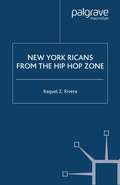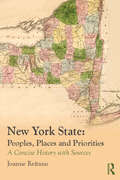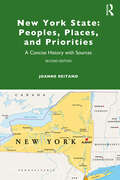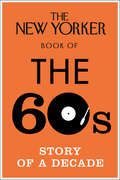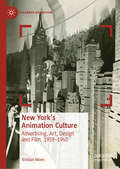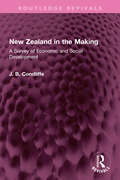- Table View
- List View
New York New Wave: The Legacy of Feminist Art in Emerging Practice (International Library of Modern and Contemporary Art)
by Kathy BattistaNew York is a centre of creative production for an exciting, emerging generation of women artists. Their work investigates themes such as the body as medium and subject matter; the deconstruction of the existing patriarchal order of the art world; the appropriation of earlier art historical references; and the use of so-called abject and everyday materials. New York New Wave investigates the relevance of earlier feminist practice for this 'new' generation, asking: Does gender difference still play a role in today's practice? How can younger women artists embrace a radical political ideology and yet remain market friendly? How far have these artists diverged from the established feminist "tradition"? Artists discussed include: Firelei Baez, EV Day, Ruby LaToya Fraser, Diana Al-Hadid, K8 Hardy, Valerie Hegarty, Cindy Hinant, Dawn Kasper, Anya Kielar, Liz Magic Laser, Narcissister, Alix Pearlstein, Aurel Schmidt, AL Steiner and W.A.G.E.
New York Ricans from the Hip Hop Zone (New Directions in Latino American Cultures)
by R. RiveraNew York Puerto Ricans have been an integral part of hip hop culture since day one: from 1970s pioneers like Rock Steady Crew's Jo-Jo, to recent rap mega-stars Big Punisher (R.I.P.) and Angie Martinez. Yet, Puerto Rican participation and contributions to hip hop have often been downplayed and even completely ignored. And when their presence has been acknowledged, it has frequently been misinterpreted as a defection from Puerto Rican culture and identity, into the African American camp. But nothing could be further from the truth. Through hip hop, Puerto Ricans have simply stretched the boundaries of Puerto Ricanness and latinidad.
New York School Collaborations: The Color of Vowels (Modern and Contemporary Poetry and Poetics)
by Mark SilverbergRanging from conceptual theater to visual poetry the New York School explored the possibilities of collaboration like no other group of American poets. New York School Collaborations gathers essays from a diverse group of scholars on the alliances and artistic co-productions of New York School poets, painters, musicians, and film-makers.
New York State: A Concise History with Sources
by Joanne ReitanoThe state of New York is virtually a nation unto itself. Long one of the most populous states and home of the country’s most dynamic city, New York is geographically strategic, economically prominent, socially diverse, culturally innovative, and politically influential. These characteristics have made New York distinctive in our nation’s history. In New York State: Peoples, Places, and Priorities, Joanne Reitano brings the history of this great state alive for readers. Clear and accessible, the book features: Primary documents and illustrations in each chapter, encouraging engagement with historical sources and issues Timelines for every chapter, along with lists of recommended reading and websites Themes of labor, liberty, lifestyles, land, and leadership running throughout the text Coverage from the colonial period up through the present day, including the Great Recession and Andrew Cuomo’s governorship Highly readable and up-to-date, New York State: Peoples, Places, and Priorities is a vital resource for anyone studying, teaching, or just interested in the history of the Empire State.
New York State: A Concise History with Sources
by Joanne ReitanoThe state of New York is virtually a nation unto itself. Long one of the most populous states and home of the country’s most dynamic city, New York is geographically strategic, economically prominent, socially diverse, culturally innovative, and politically influential. These characteristics have made New York distinctive in our nation’s history. In New York State: Peoples, Places, and Priorities, Joanne Reitano brings the history of this great state alive for readers. Clear and accessible, the book features: Primary documents and illustrations in each chapter, encouraging engagement with historical sources and issues Timelines for every chapter, along with lists of recommended reading and websites Themes of labor, liberty, lifestyles, land, and leadership running throughout the text Coverage from the colonial period up through the present day, including the Great Recession and Andrew Cuomo’s governorship Highly readable and up-to-date, New York State: Peoples, Places, and Priorities is a vital resource for anyone studying, teaching, or just interested in the history of the Empire State.
New York State: A Concise History with Sources
by Joanne ReitanoNow in its second edition, New York State: Peoples, Places, and Priorities is an accessibly written book that explores the ever-shifting dynamics of New York State history in a single volume.The text is organized both chronologically and topically, balancing political, economic, social, and cultural history. It discusses key figures, groups, movements, and controversies, upstate and downstate. Each chapter is divided into teachable, digestible sections that examine the major developments and challenges of that period, with timelines and lists of online resources to aid student understanding. The new edition brings New York State’s history into the present with coverage of recent political and economic developments, the Covid-19 pandemic, immigration, and global warming. Throughout the book, material was added concerning the American Revolution, the Civil War, women’s rights, and environmental justice. Artwork, maps, charts, and textboxes illuminate the state’s rich history. Analytical questions accompanying figures and texts encourage deeper engagement with the past.Designed for undergraduates, this book is a concise and updated account of New York State’s history over the centuries, with a wealth of resources to benefit students and instructors alike.
New York State: A Concise History with Sources
by Joanne ReitanoNow in its second edition, New York State: Peoples, Places, and Priorities is an accessibly written book that explores the ever-shifting dynamics of New York State history in a single volume.The text is organized both chronologically and topically, balancing political, economic, social, and cultural history. It discusses key figures, groups, movements, and controversies, upstate and downstate. Each chapter is divided into teachable, digestible sections that examine the major developments and challenges of that period, with timelines and lists of online resources to aid student understanding. The new edition brings New York State’s history into the present with coverage of recent political and economic developments, the Covid-19 pandemic, immigration, and global warming. Throughout the book, material was added concerning the American Revolution, the Civil War, women’s rights, and environmental justice. Artwork, maps, charts, and textboxes illuminate the state’s rich history. Analytical questions accompanying figures and texts encourage deeper engagement with the past.Designed for undergraduates, this book is a concise and updated account of New York State’s history over the centuries, with a wealth of resources to benefit students and instructors alike.
New York Times The Times of the Sixties: The Culture, Politics, and Personalities that Shaped the Decade
by The New York TimesThere is no better record of events than The New York Times, and The Times of the Sixties captures the history, culture, and personalities of the 1960s through 400 articles and original commentary with contemporary photos throughout. The Times of the Sixties represents one of the most fascinating, extensive, and well-rounded portraits of one of a tumultuous decades. More than 400 articles culled from the archives of The New York Times and curated by staff writer John Rockwell are gathered here, complete with compelling photographs from staff photographers and more. Read original, contemporary coverage of: The Cuban missile crisis Martin Luther King's I Have A Dream speech and key moments in civil rights The assassinations of President John F. Kennedy and Senator Robert Kennedy The Moon landing The Women's movement Popular music highlights like the Beatles' British Invasion and groundbreaking artists like The Supremes Movie and celebrity coverage like reviews of Psycho, 2001: A Space Odyssey, and The Graduate, and Plus articles on pivotal figures like Mao, Che Guevara, Muhammad Ali, Marilyn Monroe, and Betty Friedan And so much more.
New York Undercover: Private Surveillance in the Progressive Era (Historical Studies of Urban America)
by Jennifer FroncTo combat behavior they viewed as sexually promiscuous, politically undesirable, or downright criminal, social activists in Progressive-era New York employed private investigators to uncover the roots of society’s problems. New York Undercover follows these investigators—often journalists or social workers with no training in surveillance—on their information-gathering visits to gambling parlors, brothels, and meetings of criminal gangs and radical political organizations. Drawing on the hundreds of detailed reports that resulted from these missions, Jennifer Fronc reconstructs the process by which organizations like the National Civic Federation and the Committee of Fourteen generated the knowledge they needed to change urban conditions. This information, Fronc demonstrates, eventually empowered government regulators in the Progressive era and beyond, strengthening a federal state that grew increasingly repressive in the interest of pursuing a national security agenda. Revealing the central role of undercover investigation in both social change and the constitution of political authority, New York Undercover narrates previously untold chapters in the history of vice and the emergence of the modern surveillance state.
New York Undercover: Private Surveillance in the Progressive Era (Historical Studies of Urban America)
by Jennifer FroncTo combat behavior they viewed as sexually promiscuous, politically undesirable, or downright criminal, social activists in Progressive-era New York employed private investigators to uncover the roots of society’s problems. New York Undercover follows these investigators—often journalists or social workers with no training in surveillance—on their information-gathering visits to gambling parlors, brothels, and meetings of criminal gangs and radical political organizations. Drawing on the hundreds of detailed reports that resulted from these missions, Jennifer Fronc reconstructs the process by which organizations like the National Civic Federation and the Committee of Fourteen generated the knowledge they needed to change urban conditions. This information, Fronc demonstrates, eventually empowered government regulators in the Progressive era and beyond, strengthening a federal state that grew increasingly repressive in the interest of pursuing a national security agenda. Revealing the central role of undercover investigation in both social change and the constitution of political authority, New York Undercover narrates previously untold chapters in the history of vice and the emergence of the modern surveillance state.
The New Yorker Book of the 50s: Story of a Decade
by The New Yorker MagazineThe 1950s are enshrined in the popular imagination as the decade of poodle skirts and “I Like Ike.” But this was also a complex time, in which the afterglow of Total Victory firmly gave way to Cold War paranoia. A sense of trepidation grew with the Suez Crisis and the H-bomb tests. At the same time, the fifties marked the cultural emergence of extraordinary new energies, like those of Thelonious Monk, Sylvia Plath and Tennessee Williams.The New Yorker was there in real time, chronicling the tensions and innovations that lay beneath the era’s placid surface. In this thrilling volume, classic works of reportage, criticism, and fiction are complemented by new contributions from the magazine’s present all-star line-up of writers, including Jonathan Franzen, Malcolm Gladwell, and Jill Lepore.Here are indelible accounts of the decade’s most exciting players: Truman Capote on Marlon Brando as a pampered young star; Berton Roueché on Jackson Pollock in his first flush of fame. Ernest Hemingway, Emily Post, Bobby Fischer, and Leonard Bernstein are also brought to vivid life in these pages.Among the audacious young writers who began publishing in the fifties was one who would become a stalwart for the magazine for fifty-five years: John Updike. Also featured here are great early works from Philip Roth and Nadine Gordimer, as well as startling poems by Theodore Roethke and Anne Sexton.Completing the panoply are insightful and entertaining new pieces by present day New Yorker contributors examining the 1950s through contemporary eyes.
The New Yorker Book of the 60s: Story of a Decade
by Edited by Henry FinderThe next instalment in the acclaimed New Yorker 'decades' series featuring an all-star line-up of historical pieces from the 1960s alongside new pieces by current New Yorker staffers.The 1960s, the most tumultuous decade of the twentieth century, were a time of tectonic shifts in all aspects of society – from the March on Washington and the Second Vatican Council to the Summer of Love and Woodstock. No magazine chronicled the immense changes of the period better than The New Yorker. This capacious volume includes historic pieces from the magazine’s pages that brilliantly capture the sixties, set alongside new assessments by some of today’s finest writers.Here are real-time accounts of these years of turmoil: Calvin Trillin reports on the integration of Southern universities, E. B. White and John Updike wrestle with the enormity of the Kennedy assassination and Jonathan Schell travels with American troops into the jungles of Vietnam. The murder of Martin Luther King, Jr., the fallout of the 1968 Democratic Convention, the Soviet invasion of Czechoslovakia, the Six-Day War: all are brought to immediate and profound life in these pages. The New Yorker of the 1960s was also the wellspring of some of the truly timeless works of American journalism. Truman Capote’s In Cold Blood, Rachel Carson’s Silent Spring, Hannah Arendt’s Eichmann in Jerusalem and James Baldwin’s The Fire Next Time all first appeared in The New Yorker and are featured here. The magazine also published such indelible short story masterpieces as John Cheever’s ‘The Swimmer’ and John Updike’s ‘A & P’, alongside poems by Sylvia Plath and Anne Sexton.The arts underwent an extraordinary transformation during the decade, one mirrored by the emergence in The New Yorker of critical voices as arresting as Pauline Kael and Kenneth Tynan. Among the crucial cultural figures profiled here are Simon & Garfunkel, Tom Stoppard, Bob Dylan, Allen Ginsberg, Cassius Clay (before he was Muhammad Ali), and Mike Nichols and Elaine May.The assembled pieces are given fascinating contemporary context by current New Yorker writers, including Jill Lepore, Malcolm Gladwell and David Remnick. The result is an incomparable collective portrait of a truly galvanising era.With contributions from: Truman Capote, John Updike, E.B. White, Rachel Carson, James Baldwin, Jonathan Schell, Dwight Macdonald, Renata Adler, Hannah Arendt, Pauline Kael, AJ Liebling, Nat Hentoff, Calvin Trillin, Xavuer Rynne, John McPhee, Anthony Hiss and more.
New York's Animation Culture: Advertising, Art, Design and Film, 1939–1940 (Palgrave Animation)
by Kristian MoenThis book reveals and explores the thriving animation culture in midtown Manhattan, the World’s Fair, art galleries and cinemas during a vibrant period of artistic, commercial and industrial activity in New York City. Alongside a detailed investigation of animated film at the time – ranging from the abstract works of Mary Ellen Bute and Norman McLaren to the exhibition practices of the Disney Studios and the New York World’s Fair – New York’s Animation Culture examines a host of other animated forms, including moving dioramas, illuminated billboards, industrial displays, gallery exhibitions, mobile murals, and shop windows. In this innovative microhistory of animation, Moen combines the study of art, culture, design and film to offer a fine-grained account of an especially lively animation culture that was seen as creating new media, expanding the cinema experience, giving expression to utopian dreams of modernity, and presenting dynamic visions of a kinetic future.
New York's New Edge: Contemporary Art, the High Line, and Urban Megaprojects on the Far West Side
by David Halle Elisabeth TisoThe story of New York’s west side no longer stars the Sharks and the Jets. Instead it’s a story of urban transformation, cultural shifts, and an expanding contemporary art scene. The Chelsea Gallery District has become New York’s most dominant neighborhood for contemporary art, and the streets of the west side are filled with gallery owners, art collectors, and tourists. Developments like the High Line, historical preservation projects like the Gansevoort Market, the Chelsea galleries, and plans for megaprojects like the Hudson Yards Development have redefined what is now being called the “Far West Side” of Manhattan. David Halle and Elisabeth Tiso offer a deep analysis of the transforming district in New York’s New Edge, and the result is a new understanding of how we perceive and interpret culture and the city in New York’s gallery district. From individual interviews with gallery owners to the behind-the-scenes politics of preservation initiatives and megaprojects, the book provides an in-depth account of the developments, obstacles, successes, and failures of the area and the factors that have contributed to them.
New York's New Edge: Contemporary Art, the High Line, and Urban Megaprojects on the Far West Side
by David Halle Elisabeth TisoThe story of New York’s west side no longer stars the Sharks and the Jets. Instead it’s a story of urban transformation, cultural shifts, and an expanding contemporary art scene. The Chelsea Gallery District has become New York’s most dominant neighborhood for contemporary art, and the streets of the west side are filled with gallery owners, art collectors, and tourists. Developments like the High Line, historical preservation projects like the Gansevoort Market, the Chelsea galleries, and plans for megaprojects like the Hudson Yards Development have redefined what is now being called the “Far West Side” of Manhattan. David Halle and Elisabeth Tiso offer a deep analysis of the transforming district in New York’s New Edge, and the result is a new understanding of how we perceive and interpret culture and the city in New York’s gallery district. From individual interviews with gallery owners to the behind-the-scenes politics of preservation initiatives and megaprojects, the book provides an in-depth account of the developments, obstacles, successes, and failures of the area and the factors that have contributed to them.
New York's New Edge: Contemporary Art, the High Line, and Urban Megaprojects on the Far West Side
by David Halle Elisabeth TisoThe story of New York’s west side no longer stars the Sharks and the Jets. Instead it’s a story of urban transformation, cultural shifts, and an expanding contemporary art scene. The Chelsea Gallery District has become New York’s most dominant neighborhood for contemporary art, and the streets of the west side are filled with gallery owners, art collectors, and tourists. Developments like the High Line, historical preservation projects like the Gansevoort Market, the Chelsea galleries, and plans for megaprojects like the Hudson Yards Development have redefined what is now being called the “Far West Side” of Manhattan. David Halle and Elisabeth Tiso offer a deep analysis of the transforming district in New York’s New Edge, and the result is a new understanding of how we perceive and interpret culture and the city in New York’s gallery district. From individual interviews with gallery owners to the behind-the-scenes politics of preservation initiatives and megaprojects, the book provides an in-depth account of the developments, obstacles, successes, and failures of the area and the factors that have contributed to them.
New York's New Edge: Contemporary Art, the High Line, and Urban Megaprojects on the Far West Side
by David Halle Elisabeth TisoThe story of New York’s west side no longer stars the Sharks and the Jets. Instead it’s a story of urban transformation, cultural shifts, and an expanding contemporary art scene. The Chelsea Gallery District has become New York’s most dominant neighborhood for contemporary art, and the streets of the west side are filled with gallery owners, art collectors, and tourists. Developments like the High Line, historical preservation projects like the Gansevoort Market, the Chelsea galleries, and plans for megaprojects like the Hudson Yards Development have redefined what is now being called the “Far West Side” of Manhattan. David Halle and Elisabeth Tiso offer a deep analysis of the transforming district in New York’s New Edge, and the result is a new understanding of how we perceive and interpret culture and the city in New York’s gallery district. From individual interviews with gallery owners to the behind-the-scenes politics of preservation initiatives and megaprojects, the book provides an in-depth account of the developments, obstacles, successes, and failures of the area and the factors that have contributed to them.
New York's New Edge: Contemporary Art, the High Line, and Urban Megaprojects on the Far West Side
by David Halle Elisabeth TisoThe story of New York’s west side no longer stars the Sharks and the Jets. Instead it’s a story of urban transformation, cultural shifts, and an expanding contemporary art scene. The Chelsea Gallery District has become New York’s most dominant neighborhood for contemporary art, and the streets of the west side are filled with gallery owners, art collectors, and tourists. Developments like the High Line, historical preservation projects like the Gansevoort Market, the Chelsea galleries, and plans for megaprojects like the Hudson Yards Development have redefined what is now being called the “Far West Side” of Manhattan. David Halle and Elisabeth Tiso offer a deep analysis of the transforming district in New York’s New Edge, and the result is a new understanding of how we perceive and interpret culture and the city in New York’s gallery district. From individual interviews with gallery owners to the behind-the-scenes politics of preservation initiatives and megaprojects, the book provides an in-depth account of the developments, obstacles, successes, and failures of the area and the factors that have contributed to them.
New York's New Edge: Contemporary Art, the High Line, and Urban Megaprojects on the Far West Side
by David Halle Elisabeth TisoThe story of New York’s west side no longer stars the Sharks and the Jets. Instead it’s a story of urban transformation, cultural shifts, and an expanding contemporary art scene. The Chelsea Gallery District has become New York’s most dominant neighborhood for contemporary art, and the streets of the west side are filled with gallery owners, art collectors, and tourists. Developments like the High Line, historical preservation projects like the Gansevoort Market, the Chelsea galleries, and plans for megaprojects like the Hudson Yards Development have redefined what is now being called the “Far West Side” of Manhattan. David Halle and Elisabeth Tiso offer a deep analysis of the transforming district in New York’s New Edge, and the result is a new understanding of how we perceive and interpret culture and the city in New York’s gallery district. From individual interviews with gallery owners to the behind-the-scenes politics of preservation initiatives and megaprojects, the book provides an in-depth account of the developments, obstacles, successes, and failures of the area and the factors that have contributed to them.
New York's Newsboys: Charles Loring Brace and the Founding of the Children's Aid Society
by Karen M. StallerNew York's Newsboys is a lively historical account of Charles Loring Brace's founding and development of the Children's Aid Society to combat a newly emerging social problem, youth homelessness, during the nineteenth century. Poor children slept on the docks, pilfered, and peddled cheap wares to survive, activities which frequently landed them in prison-like juvenile asylums. Brace offered a radical alternative, the Newsboys' Lodging House. From there he launched a network of additional programs, each respecting his clients' free will, contrasting with the policing interventions favored by other reformers. Over four decades Brace built a comprehensive child welfare agency which sought to alleviate suffering, prevent delinquency, and divert children from a life of poverty. Using primary documents and analysis of over 700 original CAS case records, New York's Newsboys offers a new way to look at the foundational roots of social work and child welfare in the United States. In this book, Karen Staller argues that the significance of this chapter in history to the profession, the city of New York, and the country has been under appreciated.
New York's Newsboys: Charles Loring Brace and the Founding of the Children's Aid Society
by Karen M. StallerNew York's Newsboys is a lively historical account of Charles Loring Brace's founding and development of the Children's Aid Society to combat a newly emerging social problem, youth homelessness, during the nineteenth century. Poor children slept on the docks, pilfered, and peddled cheap wares to survive, activities which frequently landed them in prison-like juvenile asylums. Brace offered a radical alternative, the Newsboys' Lodging House. From there he launched a network of additional programs, each respecting his clients' free will, contrasting with the policing interventions favored by other reformers. Over four decades Brace built a comprehensive child welfare agency which sought to alleviate suffering, prevent delinquency, and divert children from a life of poverty. Using primary documents and analysis of over 700 original CAS case records, New York's Newsboys offers a new way to look at the foundational roots of social work and child welfare in the United States. In this book, Karen Staller argues that the significance of this chapter in history to the profession, the city of New York, and the country has been under appreciated.
A New Youth?: Young People, Generations and Family Life
by Elisabetta RuspiniA New Youth? provides a cross-cultural perspective on the challenges and problems posed by young people's transition to adulthood. The authors address questions such as: What are the experiences of being young in different European countries? What can we learn about the differences of being young in non-European countries? Are young people developing new attitudes towards society? What are the risks associated with the transition of youth to adulthood? Can we identify new attitudes about citizenship? On a more general level, are there experiences and new social meanings associated with youth? The volume is comparative between various European and non-European countries in order to identify the emerging models of transition. These characteristics are connected with broader social, political and cultural changes: changes related to extended education, increasing women's participation in the labour market, changing welfare regimes, as well as changes in political regimes and in the representation and construction of individual identities and biographies, towards an increasing individualization. The work offers critical reflections in the realm of sociology of youth by providing broader understandings of the term 'youth'. The detailed analysis of new forms of marginality and social exclusion among young people offers valuable insight for policy development and political debate.
A New Youth?: Young People, Generations and Family Life
by Elisabetta RuspiniA New Youth? provides a cross-cultural perspective on the challenges and problems posed by young people's transition to adulthood. The authors address questions such as: What are the experiences of being young in different European countries? What can we learn about the differences of being young in non-European countries? Are young people developing new attitudes towards society? What are the risks associated with the transition of youth to adulthood? Can we identify new attitudes about citizenship? On a more general level, are there experiences and new social meanings associated with youth? The volume is comparative between various European and non-European countries in order to identify the emerging models of transition. These characteristics are connected with broader social, political and cultural changes: changes related to extended education, increasing women's participation in the labour market, changing welfare regimes, as well as changes in political regimes and in the representation and construction of individual identities and biographies, towards an increasing individualization. The work offers critical reflections in the realm of sociology of youth by providing broader understandings of the term 'youth'. The detailed analysis of new forms of marginality and social exclusion among young people offers valuable insight for policy development and political debate.
New Zealand in the Making: A Survey of Economic and Social Development (Routledge Revivals)
by J. B. CondliffeFirst published in 1930, New Zealand in the Making is an economic history of the democratic experiments in New Zealand. The geography, population, government ownership of public utilities, compulsory arbitration, pensions and all other factors have been covered in detail. The book will be of interest to anyone keen on learning about New Zealand as well as to students of economy, history, agriculture, and government.
New Zealand in the Making: A Survey of Economic and Social Development (Routledge Revivals)
by J. B. CondliffeFirst published in 1930, New Zealand in the Making is an economic history of the democratic experiments in New Zealand. The geography, population, government ownership of public utilities, compulsory arbitration, pensions and all other factors have been covered in detail. The book will be of interest to anyone keen on learning about New Zealand as well as to students of economy, history, agriculture, and government.

